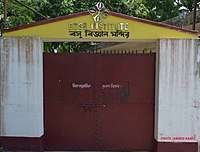Bose Institute
Bose Institute (Basu Bigyan Mandir) is a public research institute of India and also one of its oldest. The Institute was established in 1917 by Acharya Sir Jagdish Chandra Bose, the founder of modern scientific research in India. Sir JC Bose was its Director for the first twenty years till his demise. Debendra Mohan Bose, who succeeded Nobel Laureate Sir CV Raman as the Palit Professor of Physics at Rajabazar Science College campus of University of Calcutta, was the Director of Bose Institute for the next thirty years.
.svg.png) Logo of Bose Institute | |
| Type | Autonomous Research institution |
|---|---|
| Established | 1917 |
| Founder | Jagadish Chandra Bose |
| Affiliation | Department of Science and Technology (India) |
| Director | Uday Bandyopadhyay |
| Location | , , 22.5861°N 88.3937°E |
| Campus | Urban |
| Website | www |
Academics

Research
Current concentration of research is in the fields of Physics, Chemistry, Plant biology, Microbiology, Molecular medicine, Biochemistry, Biophysics, Bioinformatics and Environmental science. The Institute pioneered the concept of inter-disciplinary research in Asia and India in sync with global trends. The Institute has contributed to extremely important discoveries and has been home to internationally renowned researchers like Sambhu Nath De (discoverer of the cholera toxin), Debendra Mohan Bose (who pioneered the use of photographic emulsion plates in particle physics as attested by the Nobel Laureate Sir C. F. Powell ), Gopal Chandra Bhattacharya, Shyamadas Chatterjee (known for research on fusion) etc. The pioneering work of Jagadish Chandra Bose at the dawn of Bose institute on the effect of stimuli in plants was helpful in the establishment of the electrical nature of the conduction of various stimuli in plants.
| Directors |
|---|
|
Museum
Jagadish Chandra Bose himself started the display of his instruments which, as a continuous process, made their way into the present museum in the year 1986-87. The main purpose of this technological museum is to display and maintain some of the instruments designed, made and used by Sir J. C. Bose, his personal belongings and memorabilia. The museum is housed in the main campus at 93/1 A. P. C. road (formerly Upper Circular road) and is open on all weekdays.[1][2]
Funding
Bose institute is funded by Department of science and technology, Govt of India.[3]
Notable faculty
- Gopal Chandra Bhattacharya
- Joyoti Basu[4]
- Debendra Mohan Bose
- Jagadish Chandra Bose
- Shyamadas Chatterjee
- Sambhu Nath De
- Dipankar Home
- Indrani Bose
- Sampa Das
References
- Official website of Bose Institute, Museum of Bose Institute
- Official Website of the J.C. Bose Science Heritage Museum, Services Page
- "Bose Institute, Kolkata - Department Of Science & Technology". dst.gov.in. 28 January 2019. Retrieved 28 January 2019.
- "Indian fellow - Joyoti Basu". Indian National Science Academy. 6 December 2017. Retrieved 6 December 2017.